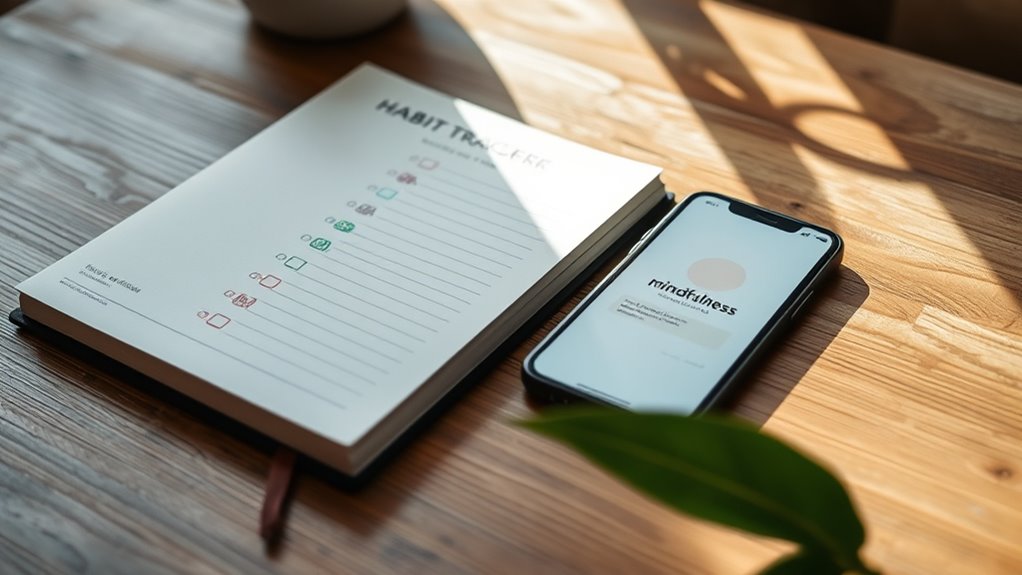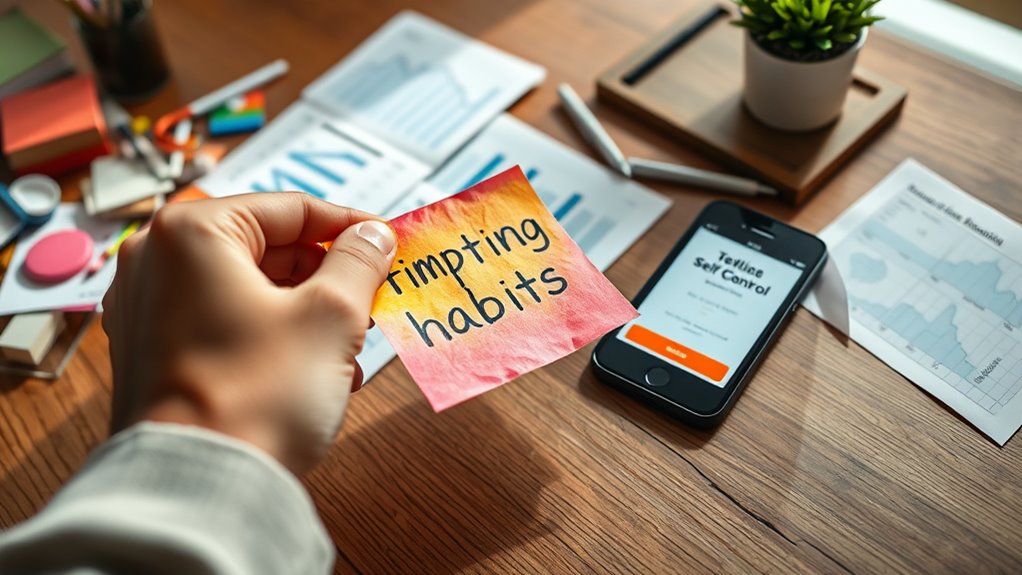Habit Building
Habit Substitution: Replace Unwanted Behaviors With Healthy Ones
An effective way to break unwanted habits is through habit substitution, but discovering the right approach can be challenging and rewarding.

To replace unwanted behaviors with healthy ones, first identify your triggers like stress or boredom. Practice mindfulness to become aware of urges without reacting automatically, giving you time to choose better options. Set small, achievable goals and develop routines that support positive changes. Use healthy replacements that satisfy the same needs, and reinforce these habits daily. Keep exploring ways to strengthen your habits, and you’ll discover effective strategies for lasting change.
Key Takeaways
- Identify triggers and emotional cues to proactively address and prevent automatic unwanted behaviors.
- Use mindfulness techniques like deep breathing and observation to create pauses before reacting.
- Set specific, manageable goals and celebrate small milestones to reinforce positive change.
- Replace habits with healthy alternatives that fulfill the same needs, making them easy to adopt.
- Combine mindfulness, goal setting, and consistent routines to build sustainable, long-term habits.

Have you ever tried to break a bad habit and found yourself struggling to succeed? It’s frustrating when old behaviors linger despite your best efforts. That’s where habit substitution comes in—replacing unwanted actions with healthier alternatives. To do this effectively, you need more than just willpower; you need a clear plan rooted in mindfulness techniques and goal setting strategies. These tools help you understand your triggers and create sustainable habits that stick.
First, recognize the situations that prompt your unwanted behavior. Are you stressed, bored, or seeking comfort? Once you identify these triggers, you can employ mindfulness techniques to stay aware of your impulses without acting on them immediately. Mindfulness encourages you to observe your thoughts and feelings objectively, creating a pause that gives you time to choose a different response. Instead of automatically reaching for a cigarette or junk food, you might notice the urge, take a deep breath, and acknowledge it without judgment. This awareness is a critical step in breaking automatic habits and gradually replacing them. Incorporating behavioral awareness can significantly enhance your capacity to identify and modify habitual responses.
Identify your triggers and practice mindfulness to pause before acting on impulses.
Next, set specific, achievable goals using effective goal setting strategies. Instead of vague resolutions like “I want to stop smoking,” opt for concrete plans such as “I will replace my cigarette breaks with five-minute brisk walks.” Break your larger goal into smaller, manageable steps. Celebrate each milestone, which reinforces your motivation and builds confidence. Write down your goals and track your progress to stay accountable. When you see improvement, even in small increments, it boosts your commitment to change.
In addition to mindfulness and goal setting, choose a healthy replacement behavior that satisfies the same need your bad habit fulfills. For example, if stress leads you to snack excessively, substitute that with drinking a glass of water or practicing deep breathing exercises. The key is to make the substitute easy to do in the moment, so it becomes your default response over time. Overcoming habits isn’t about willpower alone; it’s about creating a new routine that aligns with your long-term health and well-being.
Frequently Asked Questions
How Long Does Habit Substitution Typically Take?
Habit formation varies, but typically, it takes about 21 to 66 days to replace an unwanted behavior with a healthier one. You might see quicker results for simple habits, while more complex behavior changes could take longer. Consistency is key. By actively practicing your new behavior daily, you’ll reinforce the change and make it more automatic over time. Stay patient and persistent during your behavior change journey.
Can Habit Substitution Work for Addictive Behaviors?
Yes, habit substitution can work for addictive behaviors. By replacing a harmful addiction with healthier activities, you support behavior change and boost addiction recovery. When you focus on substituting behaviors, you create new routines that fulfill the same needs without relying on substances or destructive habits. Consistent effort and patience are key, as this method helps you gradually break free from addiction and build lasting, positive habits.
What if I Relapse Into Old Habits?
If you relapse, don’t worry—it’s common, with about 40-60% of people experiencing setbacks. Use relapse management strategies like analyzing triggers and practicing emotional resilience to get back on track. Remember, setbacks are part of the process, not failure. Stay compassionate with yourself, identify what led to the relapse, and reinforce your healthy habits. Each slip is an opportunity to learn and strengthen your commitment.
Are There Specific Habits That Are Easier to Substitute?
Yes, some habits are easier to substitute. Focus on habit pairing and cue identification; for example, replace snacking with drinking water when you notice the cue for hunger. By recognizing triggers, you can develop healthier responses. Start with simple substitutions, like walking instead of scrolling on your phone when bored. These small changes build momentum and make it easier to establish lasting, positive habits.
How Do I Stay Motivated During the Process?
To stay motivated during habit substitution, focus on your intrinsic motivation by reminding yourself why the change matters to you. Celebrate small wins to boost your confidence, and seek social support from friends or groups who encourage your progress. When setbacks happen, view them as learning opportunities rather than failures. This combination helps you maintain momentum, making the process feel more rewarding and sustainable over time.
Conclusion
Now that you know how habit substitution works, imagine the possibilities ahead. Replace that late-night snack with a invigorating walk or a quick meditation—what could happen next? Will these small changes transform your day, your habits, your life? The power is in your hands. Don’t wait—begin today. Because the moment you choose to act, you’re not just replacing a behavior—you’re opening the door to a healthier, brighter future. Are you ready to take the first step?
Habit Building
Mindful Habit Tracking: Combining Mindfulness & Data
Great habits emerge when mindfulness meets data, but understanding how your emotions influence your actions can unlock lasting change.

Mindful habit tracking combines awareness of your emotional triggers with precise data collection, helping you build more intentional and sustainable habits. By paying attention to how feelings like stress or anxiety influence your actions, you gain deeper insights into your behavior patterns. This approach makes your habits more resilient and aligned with your well-being. Keep exploring this method, and you’ll discover how emotional insights can transform your habit formation journey.
Key Takeaways
- Integrate emotional awareness into habit tracking to understand triggers and motivations behind behaviors.
- Use data to identify patterns related to emotional states, enhancing mindfulness of habitual responses.
- View setbacks as insights into emotional triggers, fostering self-compassion and intentional habit adjustments.
- Combine qualitative emotional insights with quantitative data for deeper understanding and sustainable change.
- Leverage research-backed mindfulness practices to reinforce habits and promote emotional well-being through data analysis.

Mindful habit tracking is a powerful way to build lasting change by fostering awareness and intentionality behind your daily routines. When you approach habit formation with mindfulness, you begin to notice not just what you do, but how you feel during those actions. This emotional awareness helps you connect your habits to your emotional states, making them more meaningful and easier to reinforce. Instead of mindlessly ticking off boxes, you pay attention to your motivations, triggers, and emotional responses, which deepens your understanding of your behavior patterns. This heightened awareness allows you to identify what truly drives your habits and where you might want to make adjustments, ultimately creating a more sustainable change process.
As you track your habits mindfully, you start to see the subtle nuances behind your behaviors. For example, you might notice that you tend to skip exercising on days when you’re feeling anxious or stressed. Recognizing these emotional patterns gives you the opportunity to address underlying feelings rather than just the surface behaviors. This deeper insight makes habit formation more intentional because you’re not just trying to change actions superficially—you’re working to understand the emotional context that influences them. Over time, this approach helps you develop healthier responses to emotional triggers, making your habits more resilient and aligned with your overall well-being.
Incorporating mindfulness into habit tracking also means you’re less likely to get discouraged by setbacks. Instead of viewing missed days or slip-ups as failures, you see them as opportunities for awareness. You might ask yourself what emotions prompted the lapse or why you felt resistant in that moment. This curiosity fosters self-compassion and reduces guilt, which can otherwise undermine your progress. As you become more emotionally aware, you start to notice patterns that reveal what motivates you and what holds you back, giving you tangible data to work with. It’s not just about recording whether or not you did a habit; it’s about understanding the emotional landscape that shapes your behavior, making habit formation more intentional and effective. Additionally, incorporating well-researched methods from various fields can enhance your ability to sustain these mindful practices over time.
Frequently Asked Questions
How Can Mindfulness Improve Habit Formation?
Mindfulness improves habit formation by enhancing your emotional awareness, helping you recognize triggers and patterns. Regular mindfulness meditation trains you to stay present, making it easier to notice when you’re tempted to slip into old habits. This awareness empowers you to make conscious choices, reinforcing positive behaviors. By cultivating a mindful attitude, you create a strong foundation for forming lasting habits and overcoming setbacks effortlessly.
What Tools Best Combine Mindfulness and Data Tracking?
You should try digital journaling apps and biofeedback devices to best combine mindfulness and data tracking. Digital journaling helps you reflect on your habits mindfully, while biofeedback devices provide real-time insights into your physiological responses. This combination allows you to stay aware of your mental and physical states, fostering mindful habit formation. Using these tools together keeps you engaged and informed, making it easier to develop lasting, healthy routines.
Are There Specific Habits Suited for Mindful Tracking?
Like Odysseus steering past sirens, you can track habits that deepen emotional awareness and respond to triggers. Focus on habits like meditation, journaling, or mindful breathing, which help you recognize patterns and emotional cues. These practices make you more aware of your reactions, fostering growth. By consciously observing these habits, you harness the power of mindfulness to navigate life’s challenges with clarity and purpose.
How Do I Stay Motivated With Mindful Habit Tracking?
To stay motivated with mindful habit tracking, focus on positive reinforcement by celebrating small wins and progress. Use habit visualization to imagine how completing your habits benefits your well-being, reinforcing your commitment. Remind yourself of your purpose and how each mindful step contributes to your goals. This combination keeps you engaged, inspired, and motivated to maintain consistency, making habit tracking a rewarding and meaningful experience.
Can Mindful Tracking Reduce Habit Relapse Rates?
Yes, mindful tracking can reduce habit relapse rates by increasing your emotional awareness and understanding habit cues. When you pay close attention to your feelings and triggers, you become better at recognizing early signs of relapse. This awareness helps you respond thoughtfully instead of reacting impulsively. As a result, you build resilience, stay motivated, and develop stronger habits that are less likely to relapse over time.
Conclusion
So, next time you’re obsessively checking your habit tracker, remember—you’re just another data point in the grand experiment of self-improvement. Maybe, just maybe, embracing a little mindfulness could make those tiny checkmarks feel less like a prison sentence. After all, isn’t the real goal to enjoy the journey, not just chase perfect scores? So go ahead, track away, but don’t forget to breathe—and maybe, just maybe, live a little beyond the screens.
Habit Building
Breaking Bad Habits: Using Behavioral Economics and Self‑Control
Master the secrets to breaking bad habits by harnessing behavioral economics and self-control—discover the key to lasting change and why it matters.

To break bad habits, you need to understand how your brain’s reward systems reinforce them through dopamine and triggers. Use behavioral economics strategies like replacing unhealthy rewards with healthier ones and planning responses to common triggers. Rewiring neural pathways takes consistent effort and strategic changes that focus on self-control, not just willpower. Keep exploring ways to reprogram your habits, and you’ll discover more effective techniques to create lasting change.
Key Takeaways
- Leverage behavioral economics by redesigning environments to reduce triggers and make healthy choices easier.
- Use self-control strategies like implementation intentions and commitment devices to strengthen habit change efforts.
- Replace unhealthy rewards with healthier alternatives that satisfy the brain’s craving for relief or pleasure.
- Anticipate triggers and plan specific responses to disrupt automatic habit loops effectively.
- Understand the reward system’s role in habit formation to rewire neural pathways and foster lasting change.

Breaking bad habits can feel overwhelming, but understanding how they form is the first step to change. When you look at habit formation, you’ll notice it’s a process deeply rooted in your brain’s reward systems. Every time you perform a behavior that offers some form of pleasure or relief, your brain records this as a positive experience, encouraging you to repeat it. Over time, these repeated actions become automatic, driven by cues and triggers that you might not even be fully aware of. This cycle is reinforced by your brain’s reward system, which releases chemicals like dopamine whenever you engage in a habit, making it feel satisfying and reinforcing the behavior. Recognizing this connection is vital because it shows that breaking bad habits isn’t just about willpower; it involves rewiring the reward mechanisms that keep those habits alive.
Understanding how habits form reveals they are driven by reward systems, making change possible through rewiring brain responses.
Once you understand that habits are sustained by reward systems, you can start to manipulate those systems to your advantage. Instead of simply trying to suppress the urge to perform a bad habit, you can replace or modify the reward associated with it. For instance, if you tend to snack mindlessly when stressed, you might replace that with a healthier reward—like taking a short walk or practicing deep breathing. By doing so, you’re still satisfying your brain’s craving for relief or pleasure, but in a way that aligns with your goals. This shift helps weaken the original habit loop, making it easier to form new, healthier routines. It’s important to be patient, because the habit formation process involves creating new neural pathways that compete with existing ones, which takes time and consistent effort.
Furthermore, understanding the role of reward systems can help you anticipate triggers and plan your responses. If you know that certain environments or emotions activate your desire for a bad habit, you can prepare alternative actions that provide a similar reward. For example, if boredom triggers your urge to binge-watch shows excessively, you might set a timer to limit screen time or engage in a more fulfilling activity that offers a sense of accomplishment or relaxation. Additionally, choosing appropriate health-related products like specialized shampoos or oils can support your overall well-being and reinforce positive habits. Over time, these strategic changes help reprogram your reward system, making it easier to resist old habits and develop new, healthier ones.
In essence, breaking bad habits isn’t about sheer willpower alone; it’s about understanding and reconfiguring the reward systems that sustain those habits. When you recognize how habits are formed and reinforced, you gain the power to disrupt the cycle and create lasting change.
Frequently Asked Questions
How Do Habits Form in the Brain From a Behavioral Economics Perspective?
Habits form in your brain when neural pathways strengthen through repeated behaviors, making actions automatic. From a behavioral economics perspective, your reward systems play a key role, as they reinforce behaviors that bring immediate pleasure or relief. Each time you engage in a habit, dopamine releases, strengthening neural pathways and making it more likely you’ll repeat the behavior. Over time, this creates a loop that solidifies habits in your brain.
What Role Do Incentives Play in Breaking Bad Habits Effectively?
Incentives play a pivotal role in breaking bad habits by leveraging reinforcement mechanisms to motivate change. When you align incentives with positive behaviors, you increase the likelihood of sticking to new routines. Effective incentive alignment makes healthier choices more rewarding, helping you override old patterns. By adjusting rewards and consequences, you create a compelling environment that encourages you to break bad habits and develop lasting, beneficial behaviors.
Can Self-Control Be Improved Through Specific Behavioral Strategies?
Can you boost your self-control with targeted strategies? Absolutely. You can strengthen willpower reinforcement by setting clear goals and practicing mindfulness, which helps resist temptations. Habit reversal techniques, like replacing bad habits with healthier ones, also work wonders. These behavioral strategies make self-control more sustainable, making it easier to break bad habits. Isn’t it worth trying proven methods to regain control and improve your habits over time?
How Do Environmental Cues Influence the Development of Bad Habits?
Environmental cues and context triggers strongly influence your bad habits by often signaling when to act without conscious thought. For example, seeing a snack jar might prompt you to snack mindlessly, or stress at work could trigger procrastination. These cues activate habitual responses, making it harder to resist temptations. To break this cycle, identify and modify these environmental triggers, creating new cues that promote healthier behaviors and weaken old, unwanted habits.
What Are Common Pitfalls When Trying to Change Ingrained Behaviors?
You might bite off more than you can chew, which is a common pitfall when trying to change ingrained behaviors. Habit reversal requires consistent effort, but motivation barriers often trip you up. You may underestimate the difficulty or rely on willpower alone, leading to setbacks. To succeed, set realistic goals, build new routines, and stay patient. Remember, change takes time, and persistence pays off even when progress feels slow.
Conclusion
By understanding how your habits form and leveraging behavioral economics, you can outsmart your impulses. The theory suggests that small changes and strategic choices can markedly reshape your behavior over time. Remember, self-control isn’t just about sheer willpower—it’s about designing your environment to make good habits easier and bad habits harder. Trust that consistent effort, combined with smart strategies, can truly break your bad habits and build lasting positive change.
Habit Building
Habit Rehearsal & Visualization: Mental Practice for Behavioral Change
Just imagine how habit rehearsal and visualization can transform your behavior—discover the secrets to lasting change and unlock your potential.

Habit rehearsal and visualization are powerful tools to help you rewire your brain and build new behaviors. By actively imagining your desired actions with vivid details, you strengthen neural pathways and boost confidence. This mental practice makes challenging situations feel familiar and attainable, turning intentions into habits. Consistently engaging in these techniques can transform your goals into lasting change, so keep exploring to discover how to leverage these methods for your success.
Key Takeaways
- Mental rehearsal involves vivid visualization of desired behaviors to strengthen neural pathways and rewire the subconscious mind.
- Incorporating sensory details during visualization enhances realism and boosts confidence in executing new habits.
- Consistent mental practice prepares you for challenging situations, reducing anxiety and increasing behavioral mastery.
- Visualizing behavioral cues and decision triggers helps solidify habits, making actions more automatic over time.
- Mindful imagining fosters emotional awareness, allowing you to replace doubts with empowering beliefs and maintain motivation.

Habit rehearsal and visualization are powerful tools that can help you build new habits and achieve your goals more effectively. When you practice mindful imagining, you’re consciously focusing on visualizing yourself performing a desired behavior with clarity and intention. This form of mental rehearsal involves creating vivid mental images, engaging your senses, and imagining the process as if it’s happening in real time. By doing so, you strengthen your neural pathways associated with that behavior, making it easier to act on in real life. Mental rehearsal isn’t just about wishful thinking; it’s a deliberate, focused process that primes your brain for success. When you regularly engage in this practice, you start to rewire your subconscious mind, reducing anxiety and increasing confidence about taking action.
Using mental rehearsal as part of your daily routine helps you simulate situations where you might face challenges or temptations, allowing you to mentally prepare for them. For example, if you’re trying to develop a morning workout habit, you can imagine yourself waking up energized, choosing your workout clothes, and feeling the satisfaction of completing your session. This process makes the actual experience feel more familiar and achievable. Mindful imagining also encourages you to pay attention to your emotional responses during visualization, helping you identify and manage any doubts or negative beliefs that might hold you back. This awareness allows you to replace limiting thoughts with positive, empowering ones, reinforcing your motivation to follow through.
Mentally rehearse challenges to boost confidence and replace doubts with empowering beliefs for lasting change.
Incorporating mental rehearsal into your routine isn’t complicated. Find a quiet space, close your eyes, and take a few deep breaths to center yourself. Then, vividly imagine the steps involved in your desired behavior, paying attention to details like sights, sounds, and feelings. Feel the sense of accomplishment as if you’ve already succeeded. Repeating this process consistently builds a mental blueprint that your brain recognizes as familiar, making the physical action feel more natural over time. It’s like practicing a skill in your mind before performing it in reality, which can dramatically improve your confidence and execution. Additionally, integrating payment solutions and other behavioral cues into your mental imagery can enhance your ability to develop consistent habits related to decision-making and action-taking. Over time, these mental rehearsals help solidify new habits, making it easier to act instinctively rather than relying solely on willpower.
Ultimately, mindful imagining and mental rehearsal aren’t just about wishful thinking—they’re strategic tools that turn your intentions into tangible results. When you harness the power of your mind through focused visualization, you create a mental environment primed for change. This mental practice strengthens your resolve, reduces doubt, and helps you stay committed to your goals, transforming abstract ambitions into concrete habits with consistent effort.
Frequently Asked Questions
How Long Should Each Mental Rehearsal Session Last?
You should aim for each mental rehearsal session to last about 10 to 15 minutes, following the duration guidelines for effective practice. Keep sessions consistent, ideally daily or several times a week, to reinforce your habits. Short, focused sessions are more effective than lengthy ones, helping you stay engaged. Remember, quality matters more than quantity, so make certain you’re fully immersed during each rehearsal for maximum behavioral change.
Can Visualization Replace Physical Practice Entirely?
No, visualization can’t replace physical practice entirely. Mental imagery activates neural pathways similar to actual movement, helping reinforce skills and boost confidence. However, physical practice is essential for fine-tuning motor skills, muscle memory, and real-world application. You should use visualization to complement, not substitute, physical practice—it’s a powerful tool for mental rehearsal, but it works best when combined with hands-on experience for complete mastery.
What Are Common Mistakes to Avoid During Mental Practice?
During mental practice, avoid letting your mind wander, as it can weaken your visualization. Don’t become overconfident—believing mental rehearsal alone guarantees success can lead to complacency. Stay focused and engaged, actively imagining each step vividly. Rehearse consistently without rushing, and make certain your mental images are detailed. By staying attentive and realistic, you maximize the effectiveness of your visualization and reduce the risk of mistakes.
How Often Should I Repeat Visualization Exercises?
You should repeat visualization exercises daily to see meaningful results. Think of it as hitting two birds with one stone—combine mindfulness meditation and motivational affirmations for maximum effect. Consistent practice helps reinforce positive habits and keeps you focused on your goals. Short sessions, about 5-10 minutes, are enough if done regularly. Remember, the early bird catches the worm, so start today and stay committed!
Does Mental Rehearsal Work for All Types of Habits?
Mental rehearsal can be effective for most types of habits, but its success depends on your consistency and the habit’s complexity. By using mental imagery, you activate similar neural pathways as physical practice, aiding habit formation. While it works well for behaviors like public speaking or sports, it might be less effective for deeply ingrained habits. Regular visualization enhances motivation and reinforces your commitment to change.
Conclusion
By practicing habit rehearsal and visualization regularly, you can turn your intentions into reality. These mental techniques strengthen your resolve and make positive change feel more achievable. Are you ready to take control of your habits and transform your life? Remember, each mental rehearsal brings you closer to your goals—so why not start today? Your future self will thank you for the effort you put in now. The power to change is in your mind—are you prepared to use it?
-

 Wish Notes1 year ago
Wish Notes1 year agoBest Caption to Wish Myself a Happy Birthday That Everyone Will Like!
-

 Wish Notes1 year ago
Wish Notes1 year agoThe Best Birthday Wishes to Make Your Uncle's Day Bright!
-

 Wish Notes1 year ago
Wish Notes1 year agoThe Sweetest Happy Birthday Wishes for Your Wife!
-

 Wish Notes1 year ago
Wish Notes1 year agoThe Best Happy Birthday Wish for Your Brother That Will Make Him Smile!
-

 Wish Notes1 year ago
Wish Notes1 year agoHeartwarming Birthday Messages for Mom in Spanish
-

 Wish Notes1 year ago
Wish Notes1 year agoThe Best Happy Birthday Wishes for Your Husband That Will Make His Day!
-

 Wish Notes1 year ago
Wish Notes1 year agoThe Ultimate Birthday Wishes to Celebrate Yourself!
-

 Wish Notes1 year ago
Wish Notes1 year agoThe Most Heartfelt Good Night Wishes Ever!











